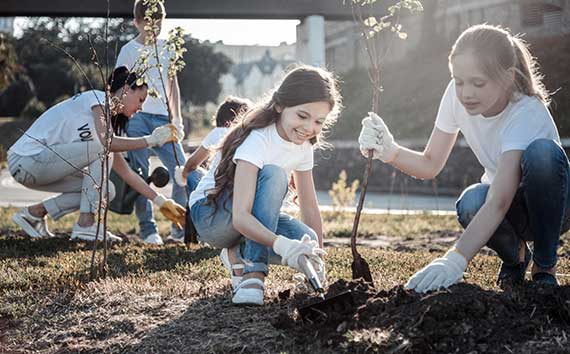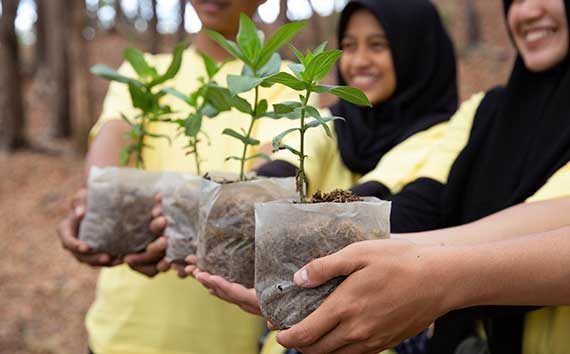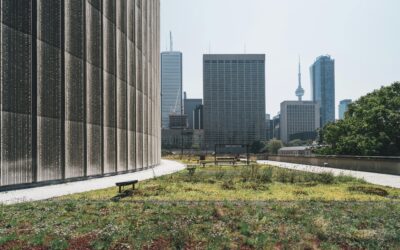Have you ever wondered how carbon is offset? There are several different ways that it can be done, but one of the most popular — and most utilized — is planting trees. And the mechanism behind this is pretty simple: just think back to sixth-grade science, where we all learned that trees take in carbon dioxide, along with sunlight and water, for photosynthesis.
As a byproduct, trees give off oxygen, which is necessary for life, and they store CO2, which has become a unavoidable byproduct for all the things we do today. Using trees for their natural ability to sequester, or capture, carbon has been instrumental in slowing atmospheric CO2 buildup and giving us a chance in the face of climate change.
However, there are limits to what trees can do. And while there are other emerging forms of offsetting, including some that are very promising, it is still better to refrain from emitting CO2 in the first place, if possible. Below is a look at how effective trees are at storing carbon, how reliable tree planting is for carbon offsets, and how this form of offsetting stacks up against other types of carbon credit systems.
How Do Offsets Work?
Basically, carbon offsets work by sequestering, or capturing, of CO2 through mechanisms that have measurable CO2-absorbing capacities. The amounts are then purchased by individuals or companies that are looking to offset their emissions. That’s what offsetting is in its simplest form.
Sequestering carbon is usually done through organic means, with trees being the current best option, as they take in CO2 for photosynthesis. Protecting forests can also be used as a form of offsetting, but this is much more complicated as the trees already exist under these circumstances. Planting trees creates new carbon stores that can be very effective if done properly.
Why Use Carbon Offsets?
Some actions cannot — at least currently — be done without emitting carbon. Whether it’s flying on an airplane or building a house that uses carbon-intensive concrete, there are certain things that emit carbon, and there’s no way around it. (Although, there are some promising developments in aviation biofuels and carbon-injected concrete, highlighting that all current carbon emissions can possibly be replaced with better options.)
For actions that put carbon in the air, carbon offsetting is the best way to remove these emissions. This should be offsetting’s main function: to negate the CO2 being emitted that we cannot directly stop by changing our own actions or habits. It is essential to minimize our carbon output in tandem with deploying offsetting measures, allowing for those offsets to go further than if we kept with the status quo.
Biking instead of driving directly keeps CO2 out of the air, which means there is less overall carbon that needs to be offset because of this direct action. Sure, when you forgo a flight to take an electric train, the flight still takes off, but you free up space for someone else. We can’t stop flying altogether, but if we can lower the amount of daily flights, we can buy time until we figure out carbon-free synthetic fuels or biofuels to decarbonize the skies.
How Much Carbon Can Trees Capture?
Different types of trees sequester different amounts of carbon, depending on the species and the location. On average, a typical hardwood tree absorbs around 20 kilograms (about 50 pounds) of CO2 per year, with fluctuations based on the age of the tree and where it is located.
At this rate, each tree sequesters about 1 metric ton of carbon within the first 40-50 years of its life, which is relatively impressive, especially if the tree can stay standing for several hundred years — and is part of a larger forest of planted trees that all take in the same amount of CO2.
Human activities currently emit around 40 billion metric tons of carbon per year. So, at our current rate, we would need to plant 40 billion trees each year to negate our total emissions each year. This would be next to impossible, as in addition to the logistical challenges of planting so many trees, we would literally run out of room for any more after just a few years of planting tens of billions of seedlings. Fortunately, we have the ability to lower our emissions from the source to bring down our annual emissions from 40 billion metric tons to something more manageable — and we can utilize different means of offsets in addition to planting trees.
Are There Different Methods of Planting Trees for Creating Carbon Offsets?
There are several ways that tree-planting outcomes can be more or less beneficial when it comes to creating carbon offsets. First of all, location matters. Trees in the northern or southern reaches of the world sequester much less CO2 than those within the tropics. This is because of a shortened growing season toward the polar ends of the earth — tropical trees are optimized for year-round photosynthesis and respiration. Evergreen trees in northern boreal forests may stay green throughout the winter, but they greatly slow down the processes that take up carbon dioxide from the atmosphere.
Aside from planting trees based on location, it is also important to plant the most optimized trees in any area — with the type of planting being even more important than the type of tree. While most tree planting is done in rows, utilizing monoculture schemes with only one species planted per plot, there is a much more beneficial method available: polyculture planting.
Polyculture planting is typically used in small-scale farming where multiple different crops are planted instead of just one. Monoculture crops are typically more widely used, especially for large-scale farming and tree planting — this is what you usually see with corn, wheat, palm oil, citrus, or any other area that has trees or plants that all look the same planted in rows.
Using polyculture methods, however, the unnatural lines of trees are eschewed in favor of something that more closely resembles how nature intended: trees and plants all mixed together, planted in a way that makes the area look more like a forest or naturally treed area.
The main drawbacks of this type of planting is that it takes longer to create and is harder to manage — but the benefits are incredible. It improves soil biodiversity, promotes healthy microfauna biodiversity (a fancy way to describe insects and small creatures), and guards against diseases that can quickly and easily spread through monoculture rows. These features make the entire area healthier than traditional monoculture areas, which has a dynamic, incredibly positive impact on the environment. But that’s not all that it accomplishes — polyculture planting also ensures more compensation and benefits for local communities in the area.
What Are Some of the Most Used Forms of Offsetting?
In addition to planting trees, there are emerging synthetic carbon capture devices and other direct carbon capture technologies that are becoming more widespread. There are four main types of offsetting that are currently being used, to differing degrees. Tree planting remains head and shoulders above the rest as far as utilization and popularity, but the other three are valid methodologies that are all seeing an increase in their usage rates as offsetting becomes more and more widespread and important.
Here are the four main types of offsetting.
Most Popular: Planting Trees
This is and has been the best way to capture carbon from the atmosphere and offset significant quantities of CO2. It’s what trees do; they take in CO2 for photosynthesis. Using their natural propensity for carbon uptake is so beneficial because of its practicality: Trees can be planted almost anywhere on Earth, and they require very little maintenance after planting.
Furthermore, we know a great deal about how to plant them, how much carbon they absorb on average, and which trees absorb more CO2 over a set number of years. This allows for a reasonable estimate of how much CO2 can be offset based on the number of trees that are planted. For this reason, and so many more factors, tree planting continues to be the best form of carbon offsetting — though the other options are getting better at a hopeful pace.
Becoming Popular: Forest Conservation
This is a great way to store a lot of carbon — and help communities with important forest resources that do not want to develop them. Compensating forested areas in exchange for them to refrain from cutting down trees is not a new idea, and it is unclear where exactly it originated. While it may seem uncomplicated and straightforward, creating offsets from conservation is tricky because the trees already exist, as opposed to planting trees that create new carbon stores.
Old growth forests absorb more CO2 than newly planted trees, which makes this form of offset more potent per acre than planting. It also confers social benefits to the regions that are compensated for protecting these forests and keeping CO2 stored in the trees. They get to benefit monetarily from their forest resources without having to exploit them — a win for everybody.
Preserving forests, especially tropical forests, not only sequesters CO2, it protects wildlife biodiversity and keeps our planet’s ecological systems regulated. We need them, so these forest conservation offsetting initiatives are crucial for so many reasons.
Less Utilized: Carbon Avoidance
This is an emerging type of offsetting that is little used at the moment — but it will become much bigger in the coming years. It involves avoiding carbon that would normally have entered the atmosphere by changing behaviors and then creating offsets out of this.
There are also other ways it can be done, such as the push to replace wood-burning stoves with renewable methanol cookstoves in Africa. Offsets are created out of these types of projects from the avoided emissions the new technologies provide. The improved tech emits less carbon, and in turn, the project is funded by the person or group that is purchasing the offsets. And, much like the other examples, this helps create a socially positive impact as well. Carbon avoidance offsets are becoming more and more popular for good reason.
Emerging: CCUS Industrial Applications
Some of the emerging technologies and applications are amazing — just don’t expect giant carbon-sucking fans that take ambient CO2 out of the air. At least not yet.
What we do have are a wide range of CCUS (carbon capture storage and utilization) options that can be fitted or retrofitted to certain processes, such as fossil fuel burning, which cannot be carbon-free by nature. What can be done is to capture the carbon these processes emit and store it in solid form, or use it to create other products, so the carbon stays in the ground rather than released into the air.
There are also some exciting new applications coming out of this, such as concrete that keeps CO2 permanently locked in a solid state within blocks — and the CO2 actually makes the concrete stronger because of the bonds it creates. Imagine living in a house that is extra sturdy due to the fact that it eliminated a chunk of CO2 emissions from a fossil fuel plant.
The Verdict on Tree-Planting Offsets
Offsetting is great. It helps ensure CO2 that is emitted is accounted for and sequestered, or captured, somewhere else. It’s also an important part of the grand carbon cycle. However, avoiding carbon from being emitted in the first place is an even better way to ensure it doesn’t remain in the atmosphere. After all, if it’s not emitted, it can’t stay in the air. It’s as simple as that.
We are still emitting too much carbon for offsetting to handle. We need to minimize our emissions to get anywhere near net-zero: There simply isn’t enough space to use tree planting as the only strategy to get to net-zero carbon emissions. We need to utilize a combination of different offsetting strategies and carbon reductions through conscious actions. There could be technological advancements that will lead to more artificial sequestration — such as direct carbon capture machines that literally suck carbon out of the air (they already exist, they’re just not really feasible yet) — but for the foreseeable future we are simply emitting more than we can offset.
While we still need to minimize our emissions to make carbon neutrality more realistic for everyone, the good news is that we can rely on the awesome power of trees to sequester and offset our excess CO2 — now and into the foreseeable future. Terrapass offers some of the highest-quality, most trustworthy carbon offsets driven by tree planting, all certified and verified by leading carbon registries to ensure transparency and — most importantly — real reductions in emissions.
Brought to you by terrapass.com
Featured image:










